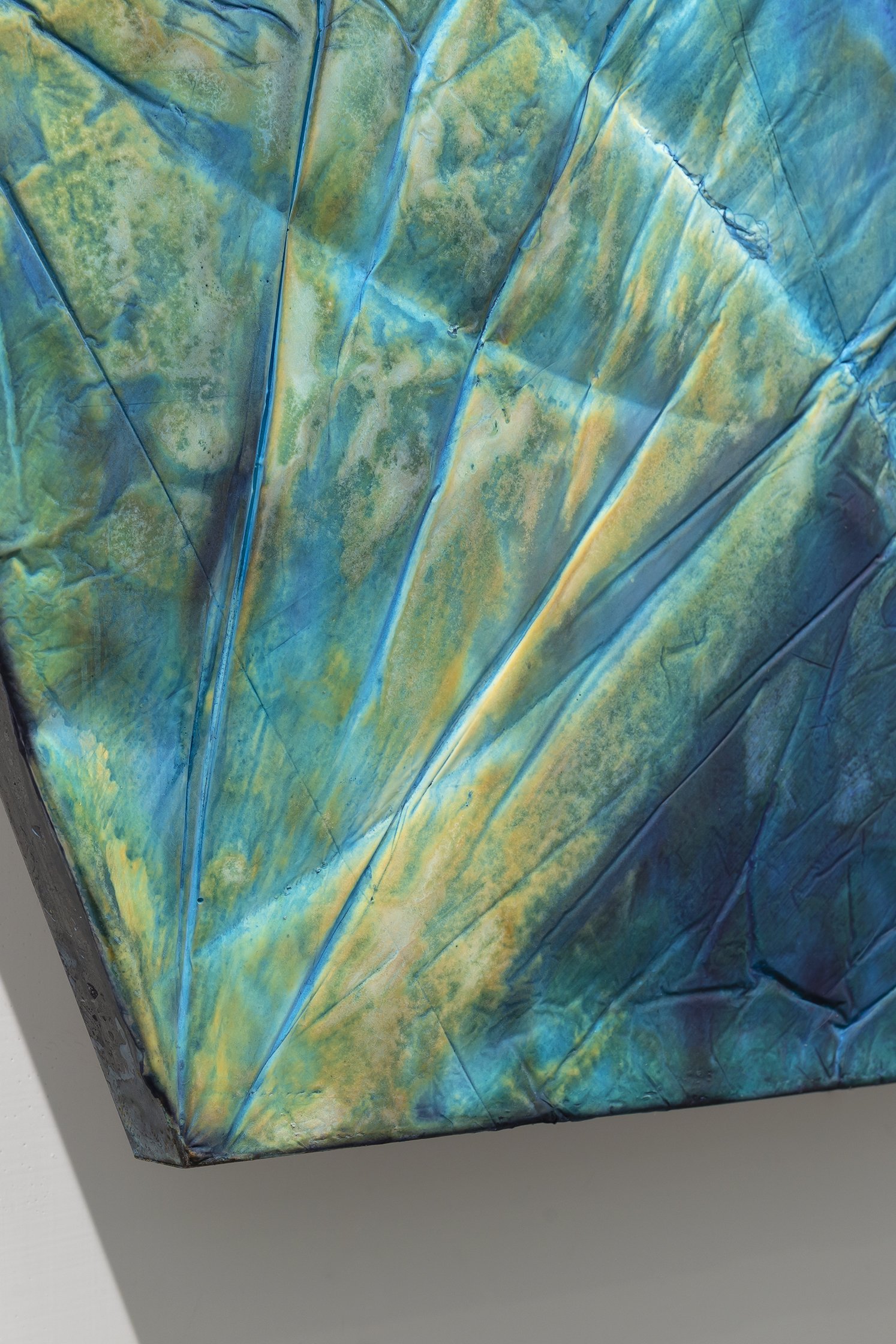3D rendering sample of an interior with Fresco installation
FRESCOS
Since 2015 Saverio has been developing the FRESCOS - bespoken transportable walls designed in collaboration with architects, interior designers, institutions, art galleries.
Based on the practice of the classical fresco technique and the Venetian stucco, these installations explore the possibilities of wall painting by mixing different techniques including fresco, carving, ink painting and printing. The Frescos are arranged in modules, each one made out of alabaster plaster and other mineral compounds, painted with ink and hold together with with metal frames. The mural painting is transformed into a portable object, independent of the wall and therefore free from the need to work on the vertical plane. Every project is unique in its size and shape and each Frescos has a specific pictorial design which, depending on the architectural context, can vary between a whole massive wall to a simple frieze or embossment. The FRESCOS expand the expression range of an abstract background through surface, colour and depth of the pictorial space.
160 x 70 cm (h x w)
1 module
1.12 m2 total
Urchin Fresco
Berlin wall
Like a cut-out of the wall, this Fresco Mobile creates a strong illusion of depth. The painting was made as a single image divided across the different modules, which have then been re-composed in situ.
240 x 300 cm (h x w)
10 modules: 120 x 75 x 4 cm
7.20 m2 total
Unborn State of Matter… — 萬物無形 形隨意生 生減有道 道萬即物
This piece was made In collaboration with Taiwanese artist Wu Chi-Tsung.The artits joined the two techniques, ink and Cyanotype photo chemicals to paint on plaster, and then exposed the fresco under the sunlight.
200 x 80 x 5 cm
1 module
ca 1,3 m2
As Above So Below
This piece is one of the first ever made frescos in 2015. It is composed of interchangeable pieces and. its richness and complexity is given by fusing together many little works painted over the years.
255 x 220 cm (h x w)
12 modules: 85 x 55 x 2 cm
5.60 m2 total
Fresco Belt
This Fresco is conceived as a belt, which adapts itself to the four sides of the column. Installed three meters high in the middle of this urban loft, a piece of sky seems to be suspended in mid-air. The fresco can be unfolded and hung straight on the wall.
70 x 180 cm (h x w)
4 modules: 70 x 45 x 2 cm
1,30 m2 total
MINERAL PAINTING
Critical text by Davide Daninos, 2016
In the last few years of his research, Saverio Tonoli has carefully devoted himself to the experimentation and refinement of a personal and elaborate pictorial technique, which finds its roots in the ancient practice of mural painting, which, although having received its canonization in the Renaissance #1, it in turn derives from a long tradition of experiments that bring us back to the early days of figurative art. Without getting enmeshed in the obligatory paths of tradition, the artist has succeeded in finding in his shrewd approach to fresco #2 a new potential and compositional freedom to give life to this pictorial medium. By removing the preparatory drawing from his equation, the wall is consequently is by necessitythe plane of vertical work, the artist ia able to concentrate on the viscosity of his colours mixed with the diluted chalk to make small boards that he himself defines as “fresco mobile”. “Fire has become the physicalness of its own pictorial medium, treated like liquid in motion whose continuous search for a formal destination becomes a generative tool in the hands of the artist. By exploiting the physical properties of his paste, Tonoli manages to cleverly integrate himself in this chemical process through multiple colour infiltrations, changing the instability and mutability of the chalk into vectors in which he is able to project his consciousness onto the materiality of the painting.
Guided by his experience and the behaviour of the materials, Tonoli is like an alchemist in the way he constructs his pictorial compositions with careful attention. They are full of expression but privy of virtuosity. His boards are never the result of a speedy expression, but they originate from a continuous negotiation that the artist keeps with his raw materials. This is a dual procedure, on the one hand, we have the technical knowledge of the artist which going back to the renaissance is part artist, part scientist and part chemist, on the other hand, the continued research of the artist demonstrates a refined know-how in his daily dialogue with the materials, allowing them to work on his paintings without being limited by internal necessities #3. I like to think that these compositions in their three-dimensionality are not only juxtapositions of tones and colours which inform the imaginative plane of the painting, but they are also results of a slow process that considers every fibre and dimension of the structure And in which the pictorial plane is only one of the ‘collateral’ results, just as the honed section of a precious stone reveals by maybe a lucky cut, a design, at times geometric, at times shapeless, but always able to make the stones “Seductive for an intimate beauty, infallible, immediate, that owes nothing to anyone” #4.
As the designs on the gems are the result of multiple transformations and geological stratifications that through the centuries have formed this secret interior, so the pictorial plan of Tonoli is built on a temporal level that is completely human, layer upon layer colour on colour, infiltration on infiltration #5. So I like to think of these boards as the combined result of the work of the material and the artist, in which the colour, calcified in the plaster, manages to create both casual and necessary aesthetic humane and natural units: scratches, incisions, brush and rag strokes combine with the emerging colours from underneath, showing continuous attention to every detail which Tonoli (who did not randomly choose photography as his second medium) describes as the “resolution” of painting. And how the cutting of hard stones could be able to create forms that in their innate beauty manage to fascinate, enchant with shapes that seemed almost intentional, maybe even a joke of nature #6, so in the boards of Tonoli such a negotiation between material and knowledge succeeds in creating a pictorial landscape of similar artifices. As certain jaspers or agates show real animal and plant shapes, but also views of forests, mountains, ruins and rivers #7, so in the boards of Tonoli the stratification of material and the many spurious colour eruptions can evoke, due to their own elaboration, multiple levels of reading and enjoyment. A ‘multidimensional’ landscape that expands before our eyes, like nature observed through a microscope, in all its details.
See Cennino Cennini, The Book of Art (1400 ca.), chap. LXVII, “The way and order to work on walls, that is, on frescoes, and to colour or make the youthful face real”, and ss. Consultation Edition: Neri Pozza Editore, Vicenza, 1971, p. 73 and ss.
Extreme synthesis the practice of painting with diluted colours on a damp surface of mortar and plaster in search of a lasting physical-chemical bond in drying and hardening caused by contact with the carbon dioxide present in the air.
It is no coincidence that the artist, in describing the balance achieved with this pictorial practice, is pleased to use the phrase “it paints itself ”.
Roger Caillois, The Writing of Stones, tr. By Angela Tizzo, Abscondita, Milan, 2013, p. 11. Original edition: L’écriture des pierres, Éditions d’Art Albert Skira, Geneva, 1970.
It is interesting to note that the final cement and lime support that closes and protects the back of the paint surface often has ‘windows’, as the artist himself defines it, the openings that show all the successive works and the stratification ff the levels, just like the section of a topographic map shows us in bright colours the various areas of the crust and the earth’s cloak.
See the theory of lusus naturae, which became central in the research for a scientific as well as aesthetic explanation of the naturalis mirabilia thus present within the European Wunderkammer from the sixteenth century.
In the European area Alberese is famous - in its typological lineage of Arno and surrounds - but the Chinese dream stones are also worth studying.

















